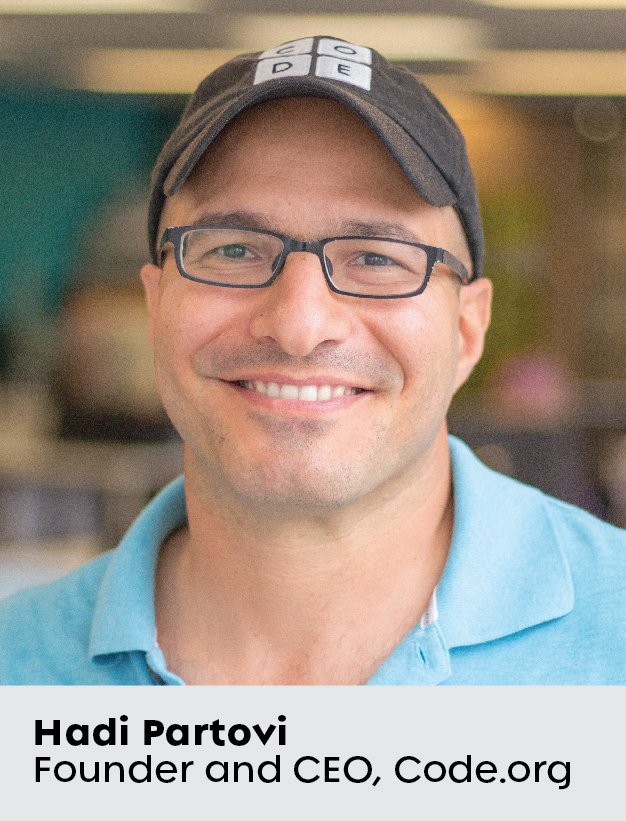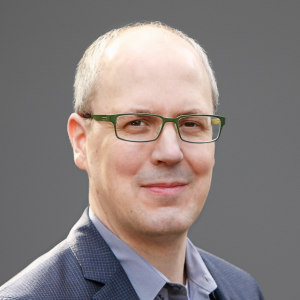How Code.org Is Teaching the World's School Kids to Code
Hadi Partovi, founder of the global education nonprofit, explains why computer science learning is key to securing the future.
As a technology pied piper, Hadi Partovi hears a lot of inspiring stories.
Since starting Code.org in 2013 as a way to teach coding to schoolkids, he’s heard from many of the nearly 500 million students his nonprofit has served worldwide.
One recent success story: The nephew of a rural Wyoming rancher used what he learned from the Code.org platform to create an app to help his uncle manage cattle.
“That’s not something we set out to enable,” says Partovi. “But knowing that in rural America, students are writing software for managing farming, it just shows that talent is everywhere, even if opportunity is not. And we’re really helping public schools spread that opportunity, and helping talented kids everywhere get a chance. The real impact is at the individual level.”
[Read also: Cybersecurity’s next generation]
Such individuals are tomorrow’s technology innovators and will be a crucial bulwark in the ongoing battle against ransomware attacks and other cyberthreats. It’s no secret to business and IT leaders that there is a severe shortage in tech talent at a time when it’s needed most.
Even before this year’s massive ransomware attacks against U.S. businesses and infrastructure, IT leaders were struggling to fill cybersecurity jobs. In the U.S., employment for information security analysts and engineers is projected to grow 31% from 2019 to 2029, according to the Bureau of Labor Statistics.
Globally, the cybersecurity industry added some 700,000 jobs in 2020, but the security-skills gap persists. The Aspen Institute’s Cybersecurity Group estimates that 500,000 info-security jobs in the U.S. alone will go unfilled this year.
All of which makes Partovi’s efforts to educate tomorrow’s technology leaders so urgent. With the help of some 1 million teachers who have signed up to teach the introductory computer science courses on the Code.org platform, Partovi’s program fills gaps in school curricula and aims to demystify computer science for a diverse and often underserved community of kids.
[Read also: 4 industries that are ready for what’s next]
“What I realized was that computer science, regardless of what job you go into, is foundational,” says Partovi. “It’s just like how you know how photosynthesis works, whether or not you do any botany in your spare time. And you know how electricity lights up a light bulb though you aren’t an electrician. Today, coding is relevant to being a citizen in an increasingly digital world.”
A foundational approach
Like many great ideas, Partovi’s was born out of frustration with the way things are—specifically, the dearth of people who know how to write computer code against the sheer volume of employers crying out for software engineers. It’s an imbalance that continues.
Every student in every school should have the opportunity to learn computer science.
“Every company I’ve worked at, invested in, or advised has the same challenge,” says Partovi, a former Microsoft executive and an early investor in Facebook, Uber, and Airbnb, who co-founded Code.org with his twin brother, Ali. “If you ask almost any tech CEO what their top problems are, whether at a giant company or a start-up, hiring talent is always one of them.”
In 2013, Partovi and his brother set up Code.org to make computer-science education available to more kids and to boost participation by women and students of color. Research also shows that kids who learn computer science do better in math, writing, and problem-solving.
[Read also: Forget 5G—all eyes are looking ahead to 6G]
Partovi hadn’t envisioned creating a formal organization. Instead, he wanted to lob a sort of manifesto into the tech world about the importance of getting people involved in coding at an early age. So, he spent much of 2012 rounding up luminaries—such as Mark Zuckerberg, Vint Cerf, the rapper will.i.am, and the NBA’s Chris Bosh—to appear in a six-minute film.
In February 2013, he uploaded “What Most Schools Don’t Teach” to YouTube. It became an overnight traffic monster. In its first week, it was viewed 10 million times. Partovi was soon flooded with requests from 20,000 teachers, all with the same message: We want your help bringing this to our school. The problem, says Partovi, was that “there was no this at the time.”
It was just the Partovi brothers, a few volunteers, and a video with what would become an enduring tagline: “Every student in every school should have the opportunity to learn computer science.”
Creating the future
Today, Code.org’s curriculum ranges from basic kindergarten classwork to Advanced Placement coding courses for high school seniors headed to college. Educators love it because everything is ready to go with a minimum of effort or setup, and with Code.org’s tools, teachers don’t need to know how to code in order to teach it.
[Read also: How Tanium is building the future of work]
The tech industry loves it, too—not only because its classes serve as the potential conduit for tomorrow’s generation of tech and security leaders, but also because it embodies the same values of inclusivity and diversity that many tech companies hope to build.
“We want to create a diverse, anti-monoculture future for cybersecurity,” says Vanessa Black, head of people programs and engagement at Tanium, which partners with Code.org through its 2% corporate Giving Pledge and its Talent of Tomorrow giving program. “We are committed to building an equitable and inclusive pipeline of incredible technical talent.”
Code.org works at all levels of education, including students, teachers, and state and national departments of education, providing curricula and a turnkey learning platform that are tuned to the age of all participants. In 2020, 31% of AP Computer Science test takers were women—an all-time high, with participation among young women improving for the seventh year in a row.
[Read also: The U.S. ransomware crisis can be solved]
As of 2021, more than 100,000 teachers have attended in-person Code.org workshops, its annual Hour of Code has become a fixture in many school schedules, and more than 2 million teachers have begun using Code.org in some fashion in the classroom. “If you’re a third-grade math teacher, a seventh-grade science teacher, or an 11th-grade gym teacher, you can use Code.org to begin teaching computer science,” says Partovi.
Room to grow
Despite the 60 million students who have accounts on Code.org, Partovi says there’s still plenty of opportunity to grow. “The majority of schools still don’t teach computer science,” he says. “Even in the schools that do, enrollment is not extended to every student.”
Getting people to understand the foundational aspect of coding is his most enduring challenge. The problem is that many parents, educators, and students think that computer science is a niche discipline, meant for a special few. But that thinking is literally from another century.
“Our nation’s education system is based on a curriculum that was designed 200 years ago,” says Partovi, “and there’s nobody whose job it is to change that. Collectively, as a society, we need to embrace computer science as a new subject in every school’s curriculum.”








